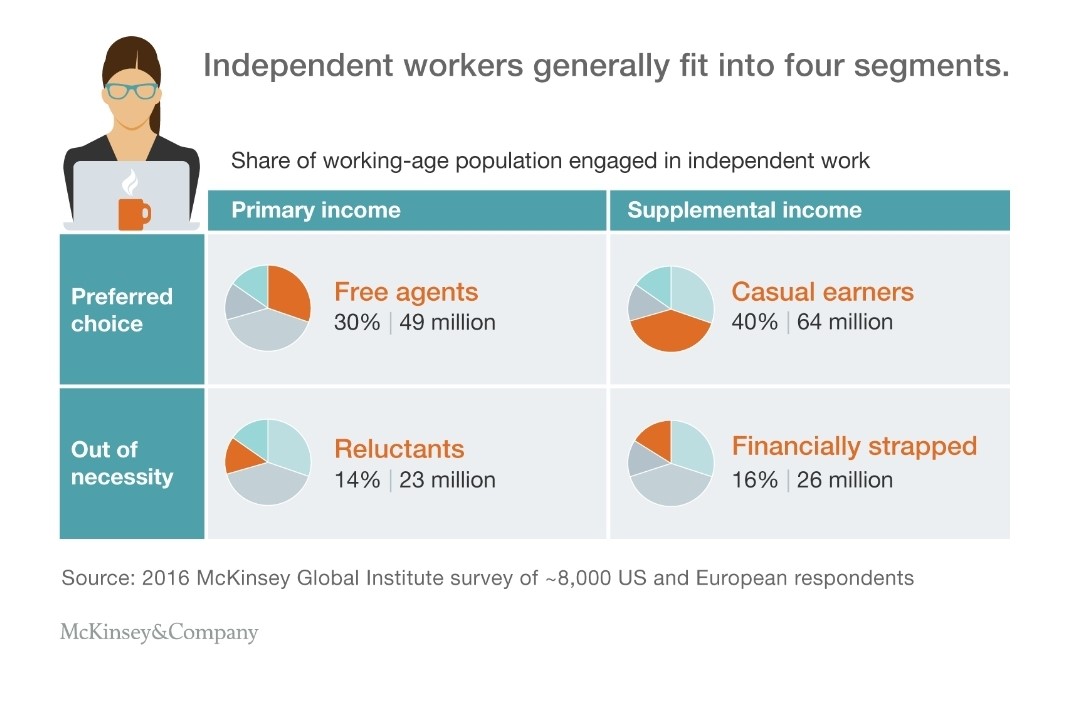What is the GIG Economy
Sharon was hitting the keyboard with her exhausted fingers when her phone let out a single beep. She ignored it and continued her frantic typing. It was almost 6 p.m., and she was already nearly twenty minutes late for her meeting with Kylie. The phone beeped once again. She ignored it once more. She knew it was kylie asking where she was. She heavily sighed as she noticed the clock arms gap increasing. The phone beeped once again. Sharon was already 45 minutes late. She hurriedly got up, gathered her stuff, and ran out of the door. Sharon threw herself out into the cold January evening. She almost ran towards the diner around the corner in her well-known fast pace. Kylie waved to Sharon the minute she entered the restaurant so she would see her. Sharon approached the table and tiredly threw her stuff on the sofa next to Kylie. She sat there apologetically as kylie looked back at her angrily.
Sharon explained that her boss asked her to enter some data into the system almost last minute. She had to work on it frantically as her boss explained that it was urgent. “Mike is always an urgent last-minute guy. Zero planning skills,” She added to Kylie. Every time Mike failed to plan, Sharon paid the price. Kylie listened annoyedly. She waited for Sharon for 45 minutes without any reply from Sharon’s side. She sat there impatiently, listening to Sharon’s venting. “Stop it”! Kylie suddenly yelled at the top of her lungs. The entire diner fell into silence as they turned their necks towards the two ladies. Sharon stared back at Kylie with shocked eyes, who looked embarrassed and shocked herself. She cleared her throat, took a couple of water sips as people went back to their business.
“I’m sorry,” she said while she hugged Sharon. “It’s just that this time it’s Mike. A few months ago, Derek never gave you time off and had you working over weekends. A couple of years ago, it was John who always put you down. A few years back, it was Amanda, “Sharon interrupted her annoyedly “this is work, Kylie! A job looks like this.” Kylie sighed desperately, “A full-time job looks like this.” Sharon looked perplexedly at Kylie. “What do you mean?” Sharon asked. “Hello, Sharon! it’s 2021! Why answer to a boss?” Kylie replied at the top of her lungs, to which the diner fell into one more awkward silence. This time people looked annoyedly back at them before they went back to their food. Kylie looked back at Sharon, who still had that curious look on her face. “The Gig Economy Sharon, Hello!” Kylie replied to that question on Sharon’s face. Kylie herself never had a full-time job for the past five years. “Tell me more about it,” inquired Sharon. To which Kylie’s face relaxed and started to explain as they finally had their meal.
What is the Gig Economy?
The gig economy refers to a labor market that consists of freelancing or part-time jobs rather than full-time, fixed contracts. Gig workers can work in various areas, including driving a cab or delivering packages, market development, editing documents, providing technical help, or performing arts. The fact that individuals work on a short-term project basis rather than as long-term employees of one firm defines a person as part of the gig economy, not their background or chosen sector.
It is also feasible to participate in the gig economy while working full-time as an employee. For example, you could work as a human resources officer during the day and supplement your income by doing some photography or graphic designing in your leisure time. Gig workers are more likely to perform a wide range of jobs than employees who work full-time for a single organization1.
The McKinsey Global Institute polled 8,000 people in Europe and the United States to understand the gig economy better. They inquired about their earnings over the last 12 months, including their principal work and any other sources of money. According to the survey, almost 162 million people in Europe and the United States, or 20 to 30% of the working-age population, engage in self-employment. While independent workers are diverse in terms of demographics, they can be divided into four categories (exhibit): free agents, who actively seek out independent work and rely on it for their primary source of income; casual earners, who are dependent on independent work for supplemental income but do not rely on it for their primary source of income; reluctance, who get their primary living from independent work but would like to work in a traditional job; and the financially squeezed, who supplement their income with independent work out of need2.

1Investopedia, 4 February 2021, Investopedia Team, Gig Economy, Accessed 19 September 2021, https://www.investopedia.com/terms/g/gig-economy.asp
N26, 10 March 2021, Accessed, N26 Team, The Rise of the GIG economy has changed the way we work forever, Accessed 19 September 2021, https://n26.com/en-eu/blog/gig-economy
2McKinsey Global Institute, 10 October 2016, James Manyika, Susan Lund, Jacques Bughin, Kelsey Robinson, Jan Mischke, and Deepa Mahajan, Independent Work: Choice, necessity, and the Gig Economy, 19 September 2021 https://www.mckinsey.com/featured-insights/employment-and-growth/independent-work-choice-necessity-and-the-gig-economy#
For more about this topic, download our latest book " Gig Economy: The New Trend That Will Take the World " for FREE:
